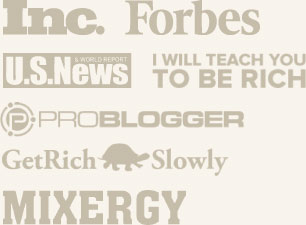"Crowdsourcing" Your Logo Design: Should You Do It? (99designs Review)
 When it comes to getting a logo designed, you have a lot of choices. Should you hire someone you know personally? Someone another company recommended? Or should you try a site where you can offer a logo “contest” and pay the winner for a logo?
When it comes to getting a logo designed, you have a lot of choices. Should you hire someone you know personally? Someone another company recommended? Or should you try a site where you can offer a logo “contest” and pay the winner for a logo?
I’ve used several different options to get logos throughout the years:
- I’ve designed a logo myself.
- I’ve hired a designer I knew personally.
- I’ve hired a logo design company.
- And, most recently, I’ve outsourced logo creation through both 99designs and Design Outpost.
In this post, I will run through each of the above four options in detail, and suggest the best course of action for getting you a great logo design at a low price–based on my own experience.
Option #1: Design It Yourself
Doing logo design yourself is cheapest, but good logo design is difficult, and your result will usually be sub-par.
You can see some of my work at the top of this page–I designed the logo for erica.biz. Though I like it, I’ll probably have it professionally redesigned at some point.
Example logo I created myself:

erica.biz, 2007.
Option #2: Hire Someone You Know
Hiring someone you know personally is great, especially if you are already familiar with his or her work. If you have seen the designer’s portfolio and spot several logos you love in it, this might be the right choice. I have done this before with a friend whose portfolio was fantastic and was 100% satisfied with the logo I received.
If you don’t like his/her portfolio, or the designer doesn’t have a portfolio, steer clear! It’s not worth the risk. The portfolio needs to have several logos in it that you fall in love with. Even if the designer comes highly recommended, if his or her “style” isn’t what you’re looking for, you won’t get a great logo.
Cons: Hiring someone who bills him/herself as a “logo designer” is frequently expensive, and if you don’t like the result, you may lose a friend as well as your money.
Example logos created by someone I knew:

Simpli Hosting, 2003. Created by friend (I think she comped this one in exchange for hosting.)

10for10.com, 2005. Created by the same friend who did the Simpli logo.
Option #3: Hire a Logo Design Company
Hiring a logo design company can be hit or miss. I hired one recently for Be The Authority–a new site I’ve been working on that I will unveil later this year. The company is well-known online and has several logo designers working at their location. I paid $395.00 for a logo with their “entry level” logo design package–a fair price.
Unfortunately, the designer who was assigned to me was terrible. She didn’t get the concept I wanted. I finally escalated it to a manager and had her removed from the project. The second designer was great and got me an excellent logo within a few days.
So, with reservations, I say this is a reasonable route, and will probably get you a nice logo. Just don’t be afraid to have the logo design company “fire” your designer if you get the short straw and your logo isn’t what you want!
Example logos created by design companies:

Be The Authority, 2009. Created by logo design company for $395. Most expensive logo I’ve bought to date.

Revamped Simpli.biz logo, 2006. Created by a design company–we won a “worst web hosting website” contest (yes, seriously!) and this was part of the prize!
Option #4: Crowdsource Your Logo Design
Finally, the subject of much controversy–“crowdsourcing” your logo. I’ve done this twice–once through Design Outpost and, more recently, through 99designs. Let’s walk through the experience.
What is crowdsourcing? Crowdsourcing refers to having an open contest for your logo and letting designers compete to win your business. With both 99designs and Design Outpost, you pay up front and set the price for your logo. You then create a “brief” — a description of what you want — and sit back and wait.
In a few days, designers from around the world submit their prospective designs. It’s your job to rank each design and give feedback to each designer.
Eventually, after a set time, your contest ends, and you pick an overall winner, who then sends you the logo in either PSD (Photoshop format; suitable for Web logos) or AI format (Adobe Illustrator–better for printing.)
Why Is Crowdsourcing Controversial?
Sounds great, right? It is–for those of us who are business owners. There is a huge community of designers who hate the concept. They call it “spec work”, meaning they do the work, but only get paid if they are the winner. In fact, some designers have even banded together to create No Spec, a website “[uniting] those who support the notion that spec work devalues the potential of design and ultimately does a disservice to the client.”
They state that many designers on 99designs and other crowdsourcing sites use stock images–images created by others. The images used are not licensed to be used in logos, and you (as the company owner and recipient of the logo) are responsible for making sure your logo doesn’t use any copyrighted work or illegally licensed images.
Of course, a designer you hire could very well use stock photography illegally as well, but it’s likely that a designer who is aware of No-Spec is also aware of how to properly use stock photography in a logo.
So, is a logo design just a logo design, or is it the heart of a “brand awareness strategy” where you will need to have 8-hour intensive “strategy sessions” with a high-priced team who then presents you with reams of paper on how to grow your brand?
There is a time and a place for both, but I’m going to take the stance that unless your company is already well into 7 figures a year and pushing 8 figures, that you don’t need the latter.
What you need is to ship (as Seth Godin would say), and you can do that with a logo. And if you want a great logo, done quickly, I recommend crowdsourcing it.
Having used both 99designs and DesignOutpost, I’d recommend 99designs. I paid less for my logo on DesignOutpost, but 99designs got me far more designers and designs to choose from.
Example logos created via design contests:

Inspiring Innovators, 2008. DesignOutpost contest. $250 to the winner, plus $25 to DesignOutpost. Total $275.
And, finally, my newest logo–for my upcoming startup company:

BestBlogs.net, 2010. 99designs contest. $310 to the winner, $70 fee to 99designs. Total $380.
How Does 99designs Work?
I strongly recommend you create an account and walk through the site as if you were a logo designer to get a feel for it. In particular, you’ll want to click “browse projects” and then “logo design” on the right, then sort by the “prize” column. This gives you a feel for how much others are paying.
After looking at this, I set my logo prize to $310. This is the “eBay mentality.” I saw a bunch of people who were at $300, and noted that my logo would be right above theirs when the contests were sorted by prize. (If you want to be really catty, you can set your logo prize at $311 or $351.)
The minimum prize is $150, but I don’t recommend this, as you won’t get a lot of choices. I’d recommend staying just above $300. (Never use a prize such as $295–there are a lot of people at $300 that your logo will be buried below.)
Writing Your Title and Subtitle
Once you set your price, you will need to write a title, subtitle, and “brief” for your contest.
The key with the title and subtitle is to market your logo contest to designers. The title should attract their attention and draw them in. Don’t use titles and subtitles like “We sell blah, blah, X, Y, and Z.” Boring!!
My title was: “BestBlogs.net = Hot new Web 2.0 startup needs bold logo!”
And my subtitle: “Designers: Looking for a high-profile branding project to put in your portfolio? This is it!”
Notice how my title, and especially my subtitle, catered to the designers instead of being all about me? This was one of the keys to having my contest be a huge success.
Writing Your Brief
Your brief is the most important part of your logo design contest. All of the designers will read it. It should contain:
- The colors you want in your logo
- Examples of other logos you like, and what you like and dislike about those logos
- Who your customers and target audience are (be specific!)
- Branding requirements (capitalization, spacing, etc.)
- What you do want (I wrote, in part: “Looking for a clean design that can easily scale down to a mobile website.”)
- What you don’t want (I wrote: “NO: cartoons; animals; stock photos; clipart; cheesy fonts”)
If you haven’t written a brief before, read several other contest briefs and pick and choose what you like from those.
There is a massive stash of great logos at logopond.com; go there, find at least 5 logos you like, and copy and paste each logo’s web address into your brief.
Should You Pay 99designs to “Promote” Your Logo Design?
Next, you get to choose some optional “promotion” methods that 99designs charges for, like making your listing bold. I didn’t choose any of these options and my contest still came out well, so I can’t say I recommend any of them.
Finally, pay your money to 99designs.
You’re all set at this point! Your contest is running.
Tips for After You’ve Submitted Your Logo
There is one thing you want to do at this point, and that’s to promote your logo contest to your fans and customers. I posted about mine several times on Twitter, for instance. Email your customers, Tweet about it, blog it, and let people know.
Guaranteeing Your Contest
Once you have received 10 logo designs, you can guarantee your contest. That means that you can no longer request a refund from 99designs, and that the winner will receive payment. This will greatly increase the number of logo designs you receive. If you have even a couple of decent logos submitted, you will definitely want to do this.
I did this when I had about 20 logos in, and 150 more logos poured in after I did it…so guaranteeing your contest is definitely effective.
Rating Designers’ Logos
Within a day or two, you will start to get logo submissions from designers, and then you can rate them. At the time my contest ended, my contest had 179 entries. Holy cow! I wasn’t expecting that many, and rating and giving feedback to each one takes time. Make sure to set aside some time each day to go through and give feedback–probably 20 minutes or so.
If you’re not sure how to rate logos, take a look at some logo design tips. Smashing Magazine has a good article on effective logo design. Also–ask your customers and potential customers. (If you have friends who aren’t potential customers, ask them, too, but weigh your decision heavily in favor of those who are or will be your customers.)
Ultimately, it’s up to you to pick a logo that looks decent and that others like, as well. Here’s my contest. Out of several logos I rated 5 stars, I ultimately picked the one I did because it was simple, straightforward, and scaled down to a mobile website easily. Your criteria may be different. (Remember, if you plan to use it in print, you probably don’t want it to have more than 2 colors plus black–make sure to specify this in your brief.)
Correspond with the designer whose logo you like most via the private message function at 99designs. Designers are required to state whether their logo violates any copyrights or uses any unlicensed stock art. If the designer says that his or her logo is original, go for it. Congratulations–your business has a logo!
Conclusion
In my opinion, 99designs and other “crowdsourcing” sites will give you a logo that is cheaper than a typical “logo designer” would charge that will be of similar quality.
It is also my strong opinion that a full-on “brand strategy” is much better saved for when you have already hit the $1 million mark. If you are running a small business, spend your money on something that will directly increase your bottom line and/or give you more time–hiring someone to do “time sink” work is a good choice, as is spending on equipment and direct marketing/sales.
Finally, a word of caution: don’t be cheap. Make the decision to invest at least $350-$400 in your logo. If you can’t afford that, it might be wisest to go without a logo for a few months. Then, make it a priority once your budget opens up a bit.
Try out 99designs for your next logo design.
Recommended Reading:
- How I Turned My Mediocre Website Into A Million-Dollar Business. Can a terrible website actually make you a million dollars?
- 20 Scam-Free Ways to Make Money Online Fast. I look at 99designs and other sites from the perspective of a logo designer.
- Why Entrepreneurs Fail (Will You Avoid These Three Traps?) Trap #3 is particularly relevant for your logo design.
Note: When I wrote this post, 99designs didn’t offer an affiliate program, so I wrote this post without expectation of return. More recently, 99designs offered an affiliate program, so I signed up for it. Now, if you start a new logo design contest and use the link above to try 99designs, you will also be helping to support erica.biz. Thank you!


